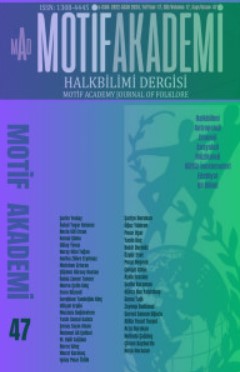DASTARHAN DOKUMANIN AŞAMALARI VE DASTARHAN, DASDAR VE CECİM ÜZERİNE KARŞILAŞTIRMALI BİR DENEME
STAGES OF DASTARHAN WEAVING AND A COMPARATIVE ESSAY ON DASTARHAN, DASDAR AND CECIM
Author(s): Aylin EraslanSubject(s): Customs / Folklore, Visual Arts, Cultural Anthropology / Ethnology, Sociology of Culture
Published by: Motif Halk Oyunları Eğitim ve Öğretim Vakfı
Keywords: Social Anthropology; Turkish Culture; Dastarhan; Dasdar; Cecim;
Summary/Abstract: Weaving is a long-established tradition in the Central Asian Turkish Cult. Traces of this deep-rooted tradition can be seen in many regions of Turkey today. In this study, my aim is to better understand the weaving stages and socio-cultural elements of dastarhan, which is frequently used in many areas such as the floor table, gift exchange, wrapping the bread (nan) considered sacred, rituals, etc. among Uzbek Turks who came to Turkey as settled immigrants from Afghanistan in 1982 and live in the Ovakent neighborhood of Antakya. My other aim is to contribute to the preservation of the dastarhan, which is an example of Turkish hand weaving art and which is thought to have survived unaltered to this day, by documenting it. Furthermore, the evaluation part of the study aims to contribute to the in-depth examination of the subject by experts by highlighting some similarities such as floor looms, tools and equipment, patterns and colors of weavings, etc. used in dastarhan, dasdar and cecim woven in Anatolia. The practice of dastarhan weaving, in which the threads were prepared in the devices set up on the streets of Ovakent in May and June 2012, attracted my attention during the field research conducted in the Ovakent neighborhood of Antakya between September 2011 and July 2012. According to our observations, it was determined that this type of weaving was on its started to disappear due to changing living conditions. For this reason, a total of four dastarhan weaving practices were observed and data were collected through in-depth interviews with 15 Uzbek women. The general evaluation of the research findings indicates that the dastarhan weaving practice, which has been practiced for centuries by Uzbek Turks who have lived in a closed and homogenous community in the Turkish region of Afghanistan, is still practiced using traditional methods also in Turkey. In addition, it has been understood that the dastarhan, which consists of many stages in terms of weaving technique, is an important part of Uzbek cosmology and has a prominent place in women's world, daily life practices such as gift giving, religious rituals, etc.
Journal: Motif Akademi Halkbilimi Dergisi
- Issue Year: 17/2024
- Issue No: 47
- Page Range: 1664-1689
- Page Count: 26
- Language: Turkish

